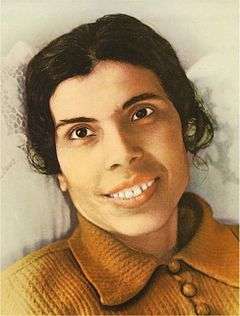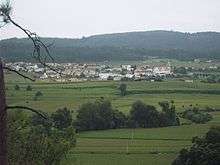Alexandrina of Balazar
Alexandrina Maria da Costa (30 March 1904 – 13 October 1955), best known as Blessed Alexandrina of Balazar, was a Portuguese mystic and victim soul, member of the Association of Salesian Cooperators, who was born and died in Balazar (a rural parish of Póvoa de Varzim). Alexandrina left many written works, which have been studied mainly in Italy by Father Umberto Pasquale. On 25 April 2004 she was declared blessed by Pope John Paul II who stated that "her secret to holiness was love for Christ".[1]
Blessed Alexandrina of Balazar, ASC | |
|---|---|
 Portrait of Blessed Alexandrina in a prayer-card | |
| Virgin / Victim soul / Salesian Cooperator | |
| Born | 30 March 1904 Balazar, Póvoa de Varzim, Portugal |
| Died | 13 October 1955 (aged 51) Balazar, Póvoa de Varzim, Portugal |
| Venerated in | Catholic Church |
| Beatified | 25 April 2004, St. Peter's Square, Vatican by Pope John Paul II |
| Major shrine | Sanctuary Alexandrina of Balazar (where her body rests) |
| Feast | October 13 |
| Attributes | Member of the Association of Salesian Cooperators |
| Patronage | Youth people; against sexual temptations; penitent women |
Early life

Alexandrina Maria da Costa was born on 30 March 1904, in Balazar, a rural parish of Póvoa de Varzim, Portugal. Her father abandoned the family when she was very young. She had only eighteen months' schooling before being sent to work on a farm at the age of nine. In her teens she started to work in Balazar as a seamstress along with her sister.[2]
Alexandrina said that when she went with other girls to the countryside, she picked flowers that she later used to make flower carpets to the Church of Our Lady of Sorrows in Póvoa de Varzim. One day, she started bleeding from her head, due to a crown of spines, she said. Jesus spoke to her and called her Alexandrina das Dores (Alexandrina of Sorrows).
At 14 years old, in March 1918 an incident changed her life. Her former employer along with two other men tried to break into her room. To escape them, Alexandrina jumped 13 feet down from a window, barely surviving. Her spine was broken from the fall. Until age 19, Alexandrina was still able to "drag herself" to church where, hunched over, she would remain in prayer, to the great amazement of the parishioners. During the early years, Alexandrina asked the Blessed Mother for the grace of a cure. She suffered gradual paralysis that confined her to bed from 1925 onward. She remained bed-ridden for about 30 years.[2][3]
The parish priest lent her a statue of the Immaculate Heart of Mary for the month of May. She asked for a little altar to be fixed to the wall by her bed where it was graced with the statue of Our Lady of Fatima and decorated with flowers and candles.
Later life
In June 1938, based on the request of Alexandrina's confessor, Father Mariano Pinho SJ, several bishops from Portugal wrote to Pope Pius XI, asking him to consecrate the world to the Immaculate Heart of Mary.[4][5]
This request was renewed several times until 1941, in which the Holy See asked three times more information about Alexandrina to the Archbishop of Braga. At that time, Cardinal Eugenio Pacelli (later Pope Pius XII) was the secretary of the state of the Vatican, and he later performed the consecration of the world.[6] The Holy See recognized the relation of Alexandrina Maria da Costa with the act of the World Consecration to the Immaculate Heart of Mary in an article about her life and virtues.[7]
After December 1938, she corresponded regularly with Sister Lucia.[8]
According to her Vatican biography, from March 1942, for about 13 years until her death, she received no food except for the Holy Eucharist, and her weight dropped to about 33 kilograms (i.e. approximately 73 pounds). She was examined by medical doctors, with no conclusion.[2][3]
Based on the advice of a priest, her sister kept a diary of Alexandrina's words and mystical experiences. According to her Vatican autobiography Jesus spoke to her, at one point saying: "You will very rarely receive consolation... I want that while your heart is filled with suffering, on your lips there is a smile".[3] In 1944, she joined the "Union of Salesian Cooperators", offering her suffering for the salvation of souls and for the sanctification of youth.[3]
Umberto Pasquale (1906 - 1985) was a Salesian priest and writer. At the beginning of the 1930s, he went to Portugal and in 1944 he met Alexandrina Maria da Costa, the main subject of his books.
Legacy

Based on her request, the following words were written on her tombstone:[3]
- "Sinners, if the dust of my body can be of help to save you, come close, walk over it, kick it around until it disappears. But never sin again: do not offend Jesus anymore! Sinners, how much I want to tell you.... Do not risk losing Jesus for all eternity, for he is so good. Enough with sin. Love Jesus, love him!".
In Ireland there is an Alexandrina Society that spreads knowledge of her life and teachings. The aims of the Society are 1) To spread devotion to Alexandrina and make her known, 2) To pray for the conversion of sinners, 3) To pray for Priests and acknowledge any favours received, 4) To pray for members' intentions.[9]
See also
References
- "25 April 2004: Beatification of six Servants of God - John Paul II". www.vatican.va. Retrieved 27 December 2017.
- Freze, Michael. 1993, They bore the wounds of Christ, OSV Publishing ISBN 0-87973-422-1 page 279
- "Alexandrina Maria da Costa (1904-1955), biography". www.vatican.va. Retrieved 27 December 2017.
- The first consecration of the world to the Immaculate Heart of Mary by José Ferreira
- For Love Alone! by COSTA, Alexandrina Maria (organized by Eugénie Signorile and translated into English by Leo Baron Madigan of Lumiar)
- Totus tuus: John Paul II's program of Marian consecration and entrustment by Msgr Arthur Burton Calkins 1992 ISBN 0-9635345-0-5 page 97
- "Alexandrina Maria da Costa (1904-1955), biografia". www.vatican.va. Retrieved 27 December 2017.
- "Fr Umberto Pasquale SDB". www.ewtn.com. Retrieved 27 December 2017.
- "Blessed Alexandrina Society". alexandrinabalasar.free.fr. Retrieved 27 December 2017.
Further reading
- MADIGAN, Leo; Blessed Alexandrina Maria da Costa, the Mystical Martyr of Fátima. Fatima-Ophel Books, Fátima, Portugal (2005).
- JOHNSTON, Francis W.; Alexandrina: The Agony and the Glory. Saint Benedict Press, TAN Books (2009).
- Rowles, Kevin. Blessed Alexandrina - Living Miracle of the Eucharist. Twickenham, United Kingdom (2006)